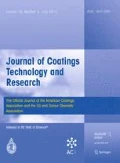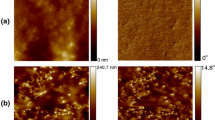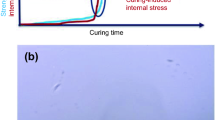Abstract
The relationship between chemical degradation and thickness loss of an unpigmented, non UV-stabilized, crosslinked amine-cured epoxy coating exposed to three UV conditions was investigated. Spin-coated samples having a thickness of approximately 7 μm on an Si substrate were prepared from a stochiometric mixture of a bisphenol A epoxy resin and a tetra-functional amine curing agent. Samples were exposed outdoors and to two accelerated laboratory UV environments. Chemical degradation and thickness loss were measured by transmission Fourier transform infrared spectroscopy (FTIRS) and laser scanning confocal microscopy (LSCM), respectively. In addition, surface roughness and morphological changes were measured by atomic forcemicrosocopy (AFM) and LSCM. Substantial chemical degradation, thickness loss, and morpholocal changes occurred in the exposed films, and the rate of chemical degradation was greater than that due to the thickness loss. This additional chemical loss was attributed to an inhomogeneous degradation process in which nanoscale localized depressions initiate at certain sites on the surface, which then enlarge and deepen with exposure time. The results of this study provide a better understanding of the degradation mechanism and should lead to the development of scientific-based models for predicting the service life of crosslinked amine-cured epoxy coatings.
Similar content being viewed by others
References
Rabek, J.F.,Polymer Photodegration—Mechanisms and Experimental Methods, Chapman & Hall, New York, pp. 269–278, 1995.
Bellinger, V., Bouchard, C., Claveirolle, P., and Verdu, J., “Photo-oxidation of Epoxy Resins Cured by Non-Aromatic Amines,”Photochemistry, 1, 69 (1981).
Bellinger, V. and Verdu, J., “Oxidative Skeleton Breaking in Epoxy-Amine Networks,”J. Appl. Polym. Sci., 30, 363 (1985).
Gerlock, J.L., Smith, C.A., Nunez, E.M., Cooper, V.A., Liscombe, P., Cummings, D.R., and Dusibiber, T.G., “Measurements of Chemical Change Rates to Select Superior Automotive Clearcoats,” inPolymer Durability, in Advances in Chemistry Series 249, Clough, R., Billinham, N., and Gillen, K. (Eds.), American Chemical Society, Washington, DC, pp. 335–347, 1996.
Croll, S.G. and Skaja, A.D., “Quantitative Spectroscopy to Determine Effects of Photodegradation on a Model Polyester-Urethane Coating,”J. Coat. Technol., 75, No. 945, 85 (2003).
Wernsath, K.L., “Service Life Prediction of Automotive Coatings, Correlating Infrared Measurements and Gloss Retention,”Polym. Degrad. Stab., 54, 57 (1996).
Decker, C. and Zahouily, K., “Photodegradation and Photooxidation of Thermoset and UV-Cured Acrylate Polymers,”Polym. Degrad. Stab., 64, 293 (1999).
Nguyen, T., Gu, X., VanLandingham, M.R., Ryntz, R., Nguyen, D., and Martin, J.W., “Nanoscale Characterization of Coatings Surface Degradation with Tapping Mode AFM,”Proc. Adhesion Society Meeting, Anderson, G.L (Ed.), p. 505, 2003.
VanLandingham, M.R., Nguyen, T., Byrd, W.E., and Martin, J.W., “On the Use of the Atomic Force Microscope to Monitor Physical Degradation of Polymeric Coating Surfaces,”J. Coat. Technol., 73, No. 923, 43 (2001).
Nguyen, T., Gu, VanLandingham, M.R., Byrd, E., Martin, D., Ryntz, R., and Martin, J.W., “Degradation Modes of Polymeric Coatings Exposed to UV”,Proc. Coatings, for Plastics Symposium, Troy, MI, July 2004.
Sung, L., Jasmin, J., Gu, X., Nguhen, T., and Martin, J.W., “Use of Laser Scanning Confocal Microscopy for Characterizing Changes in Film Thickness and Local Surface Morphology of UV Exposed Polymer Coatings,”J. Coat. Technol. Res., 1, No. 4, 267 (2004).
Martin, J.W., Nguyen, T., Byrd, W.E., Dickens, B., and Embree, N., “Relating Laboratory and Outdoor Exposures of Coatings: 1. Cumulative Damage Model and Laboratory Experiment Apparatus,”Polym. Degrad. Stab., 75, 1, 193 (2002).
Nguyen, T., Martin, J.W., Byrd, W.E., and Embree, N., “Relating Laboratory and Outdoor Exposure of Coatings: III. Effects of Humidity on Moisture-Enhanced Photolysis of Acrylic-Melamine Coatings,”Polym. Degrad. Stab., 77 1, 1 (2002).
Nguyen, T., Martin, J.W., Byrd, W.E., and Embree, N., “Relating Laboratory and Outdoor Exposures of Coatings: II. Effects of Relative Humidity on Photodegradation of Acrylic Melamine,”J. Coat. Technol., 74, No. 932, 31 (2002).
Corle, T.R. and Kino, G.S.,Confocal Scanning Optical Microscopy and Related Imaging Systems, Academic Press, 1996.
Brandrup, J., Immergut, E.H., and Grulke, E.A. (Eds.),Polymer Handbook, John Wiley, Inc, New York, NY, p. VI-576 1999.
Magonov, S.N. and Heaton, M.G., “Atomic Force Microscopy, Part 6: Recent Developments in AFM of Polymers,”Am. Lab., 30, 9 (May 1998).
Sauer, B.B., McLean, R.S., and Thomas, R.R., “Tapping Mode AFM Studies of Nano-Phases on Fluorine-Containing Polyester Coatings and Octadecyltrichlorosilane Monolayers,”Langmuir, 14, 3045 (1998).
Gu, X., Raghavan, D., Ho, D.L., Sung, L., VanLandingham, M.R., and Nguyen, T., “Nanocharacterization of Surface and Interface of Different Epoxy Networks,”Mater. Res. Soc. Symp., 710, DD10. 9 (2002).
Gu, X., Martin, D., Martin, W.J., and Nguyen, T., “Surface, Interface, and Bulk Microstructure of Amine-Cured Epoxies—An Intensive AFM Study”,Proc. Adhesion Society Meeting, Chaudhury, M. (Ed.), p. 507, 2004.
Chen, X., McGurk, S.L., Davies, M.C., Roberts, C.J., Shakesheff, K.M., Tendler, S.J.B., and Williams, P.M., “Chemical and Morphological Analysis of Surface Enrichment in a Biodegradable Polymer Blend by Phase-Detection Imaging Atomic Force Microscopy,”Marcomole-cules, 31, 2278 (1998) and references therein.
Pienka, Z., Oike, H., and Tezuka, Y., “Atomic Force Microscopy Study of Environmental Responses on Poly(vinyl alcohol)-graft-Polystyrene Surfaces,”Langmuir, 15, 3197 (1999) and references therein.
VanLandingham, M.R., Eduljee, R.F., and Gillespie, J.W., “Relationship Between Stoichiometry, Microstructure, and Properties of Amine-Cured Epoxies,”J. Appl. Polym. Sci., 71, 699 (1999).
Gu, X., VanLandingham, M.R., Raghavan, D., and Nguyen, T., “Characterization of Polyester Degradation in Alkaline Solution with AFM,”Polym. Degrad. Stab., 74, 139 (2001).
Nguyen, T., Martin, J.W., Byrd, W.E., and Embree, N., “Relating Laboratory and Outdoor Exposures of Coatings: IV. Mode and Mechanism of Hydrolysis of Acrylic-Melamine Coatings,”J. Coat. Technol., 75, No. 941, 37 (2003).
Bar, G., Thomann, Y., Brandsch, R., and Whangbo, M.H., “Factors Affecting the Height and Phase Images in Tapping Mode Atomic Force Microscopy. Study of Phase-Separated Polymer Blends of Poly(ethene-co-styrene) and Poly(2,6-dimethyl-1,4-phenylene oxide),”Langmuir, 13, 3807 (1997).
Magonov, S.N., Elings, V., and Whangbo, M.H., “Phase Imaging and Stiffness in Tapping Mode Atomic Force Microscopy,”Surf. Sci., 375, L385 (1997).
Cuthrell, R.E., “Epoxy Polymers. II. Macrostructure,”J. Appl. Polym. Sci., 12, 1263 (1968).
Giraud, M., Nguyen, T., Gu, X., and VanLandingham, M.R., “Effects of Stoichiometry and Epoxy Molecular Mass on Wettability and Interfacial Microstructures of Amine-Cured Epoxies,”Proc. Adhesion Society Meeting, Emerson, J.A. (Ed.), p. 260, 2001.
Bascom, W.D., “Water at the Interface,”J. Adhes, 2, 168 (1970).
Leadley, S.R., Shakesheff, K.M., Davies, M.C., Heller, J., Franson, N.M., Paul, A.J., Brown, A.M., and Watts, J.M., “The Use of SIMS XPS, and In Situ AFM to Probe, the Acid Catalysed Hydrolysis of Polytorthoesters),”Biomaterials, 19, 1353 (1998).
Gopferich, A. and Langer, R., “The Infleunce of Microstructure and Monomer Properties on the Erosion Mechanism of a Class of Polyanhydrides,”J. Polym. Sci., Part A: Polym. Chem., 31, 2445 (1993).
Author information
Authors and Affiliations
Rights and permissions
About this article
Cite this article
Rezig, A., Nguyen, T., Martin, D. et al. Relationship between chemical degradation and thickness loss of an amine-cured epoxy coating exposed to different UV environments. J Coat Technol Res 3, 173–184 (2006). https://doi.org/10.1007/BF02774507
Issue Date:
DOI: https://doi.org/10.1007/BF02774507




